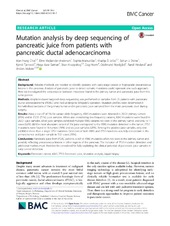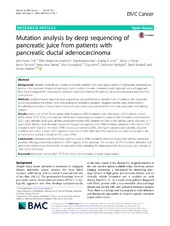| dc.contributor.author | Choi, Man Hung | en_US |
| dc.contributor.author | Mejlænder-Andersen, Eline | en_US |
| dc.contributor.author | Manueldas, Sophia | en_US |
| dc.contributor.author | el Jellas, Khadija | en_US |
| dc.contributor.author | Steine, Solrun | en_US |
| dc.contributor.author | Tjensvoll, Kjersti | en_US |
| dc.contributor.author | Sætran, Hege Aase | en_US |
| dc.contributor.author | Knappskog, Stian | en_US |
| dc.contributor.author | Hoem, Dag | en_US |
| dc.contributor.author | Nordgård, Oddmund | en_US |
| dc.contributor.author | Hovland, Randi | en_US |
| dc.contributor.author | Molven, Anders | en_US |
| dc.date.accessioned | 2020-05-22T11:34:35Z | |
| dc.date.available | 2020-05-22T11:34:35Z | |
| dc.date.issued | 2019-01-05 | |
| dc.Published | Choi MH, Mejlænder-Andersen, Manueldas S, el Jellas KE, Steine S, Tjensvoll K, Sætran HA, Knappskog S, Hoem D, Nordgård O, Hovland R, Molven A. Mutation analysis by deep sequencing of pancreatic juice from patients with pancreatic ductal adenocarcinoma. BMC Cancer. 2019;19:11(1), 11 (2019) | eng |
| dc.identifier.issn | 1471-2407 | |
| dc.identifier.uri | https://hdl.handle.net/1956/22347 | |
| dc.description.abstract | Background Reliable methods are needed to identify patients with early-stage cancer or high-grade precancerous lesions in the pancreas. Analysis of pancreatic juice to detect somatic mutations could represent one such approach. Here we investigated the concordance between mutations found in the primary tumor and pancreatic juice from the same patient. Methods Amplicon-based targeted deep sequencing was performed on samples from 21 patients with pancreatic ductal adenocarcinoma (PDAC) who had undergone Whipple’s operation. Mutation profiles were determined in formalin-fixed sections of the primary tumor and in pancreatic juice sampled from the main pancreatic duct during surgery. Results Using a cut-off of 3% for variant allele frequency, KRAS mutations were detected in 20/21 primary tumors (95%) and in 15/21 (71%) juice samples. When also considering low-frequency variants, KRAS mutations were found in 20/21 juice samples. Most juice samples exhibited multiple KRAS variants not seen in the primary tumor, and only in 11 cases (52%) did the most abundant variant of the juice correspond to the KRAS mutation detected in the tumor. TP53 mutations were found in 16 tumors (76%) and six juice samples (29%). Among the positive juice samples, only one exhibited more than a single TP53 mutation. Detection of both KRAS and TP53 mutations was fully concordant in the primary tumor and juice sample in 7/21 cases (33%). Conclusions Pancreatic juice from PDAC patients is rich in KRAS mutations often not seen in the primary tumor and possibly reflecting precancerous lesions in other regions of the pancreas. The inclusion of TP53 mutation detection and additional markers must therefore be considered for fully exploiting the clinical potential of pancreatic juice samples in early cancer detection. | en_US |
| dc.language.iso | eng | eng |
| dc.publisher | BMC | eng |
| dc.rights | Attribution CC BY | eng |
| dc.rights.uri | http://creativecommons.org/licenses/by/4.0/ | eng |
| dc.title | Mutation analysis by deep sequencing of pancreatic juice from patients with pancreatic ductal adenocarcinoma | en_US |
| dc.type | Peer reviewed | |
| dc.type | Journal article | |
| dc.date.updated | 2019-12-27T11:03:32Z | |
| dc.description.version | publishedVersion | en_US |
| dc.identifier.doi | https://doi.org/10.1186/s12885-018-5195-7 | |
| dc.identifier.cristin | 1693074 | |
| dc.source.journal | BMC Cancer | |


